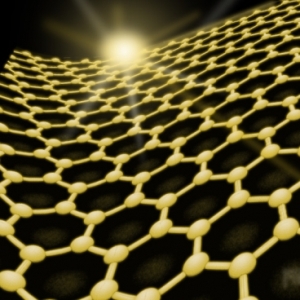Jan 7 2011
A promising approach for making solar cells that are inexpensive, lightweight and flexible is to use organic (that is, carbon-containing) compounds instead of expensive, highly purified silicon. But one stubborn problem has slowed the development of such cells: Researchers have had a hard time coming up with appropriate materials for the electrodes to carry the current to and from the cells. Specifically, it has been hard to make electrodes using materials that can match the organic cells’ flexibility, transparency and low cost.
The standard material used so far for these electrodes is indium-tin-oxide, or ITO. But indium is expensive and relatively rare, so the search has been on for a suitable replacement. Now, a team of MIT researchers has come up with a practical way of using a possible substitute made from inexpensive and ubiquitous carbon. The proposed material is graphene, a form of carbon in which the atoms form a flat sheet just one atom thick, arranged in a chicken-wire-like formation.
 The structure of graphene, a flexible material made of carbon atoms arranged in a layer just one atom thick, is represented in this diagram.
The structure of graphene, a flexible material made of carbon atoms arranged in a layer just one atom thick, is represented in this diagram.
An analysis of how to use graphene as an electrode for such solar cells was published on Dec. 17 in the journal Nanotechnology, in a paper by MIT professors Jing Kong and Vladimir Buloviæ along with two of their students and a postdoctoral researcher.
Graphene is transparent, so that electrodes made from it can be applied to the transparent organic solar cells without blocking any of the incoming light. In addition, it is flexible, like the organic solar cells themselves, so it could be part of installations that require the panel to follow the contours of a structure, such as a patterned roof. ITO, by contrast, is stiff and brittle.
The biggest problem with getting graphene to work as an electrode for organic solar cells has been getting the material to adhere to the panel. Graphene repels water, so typical procedures for producing an electrode on the surface by depositing the material from a solution won’t work.
The team tried a variety of approaches to alter the surface properties of the cell or to use solutions other than water to deposit the carbon on the surface, but none of these performed well, Kong says. But then they found that “doping” the surface — that is, introducing a set of impurities into the surface — changed the way it behaved, and allowed the graphene to bond tightly. As a bonus, it turned out the doping also improved the material’s electrical conductivity.
While the specific characteristics of the graphene electrode differ from those of the ITO it would replace, its overall performance in a solar cell is very similar, Kong says. And the flexibility and light weight of organic solar cells with graphene electrodes could open up a variety of different applications that would not be possible with today’s conventional silicon-based solar panels, she says. For example, because of their transparency they could be applied directly to windows without blocking the view, and they could be applied to irregular wall or rooftop surfaces. In addition, they could be stacked on top of other solar panels, increasing the amount of power generated from a given area. And they could even be folded or rolled up for easy transportation.
While this research looked at how to adapt graphene to replace one of the two electrodes on a solar panel, Kong and her co-workers are now trying to adapt it to the other electrode as well. In addition, widespread use of this technology will require new techniques for large-scale manufacturing of graphene — an area of very active research. The ongoing work has been funded by the Eni-MIT Alliance Solar Frontiers Center and an NSF research fellowship.
Peter Peumans, an assistant professor of electrical engineering at Stanford University, who was not involved in this study, says organic solar cells will probably become practical only with the development of transparent electrode technology that is both cheaper and more robust than conventional metal oxides. Other materials are being studied as possible substitutes, he says, but this work represents “very important progress” toward making graphene a credible replacement transparent electrode.
“Other groups had already shown that graphene exhibits good combinations of transparency and sheet resistance, but no one was able to achieve a performance with graphene electrodes that matches that of devices on conventional metal oxide (ITO) electrodes,” Peumans says. “This work is a substantial push toward making graphene a leading candidate.”